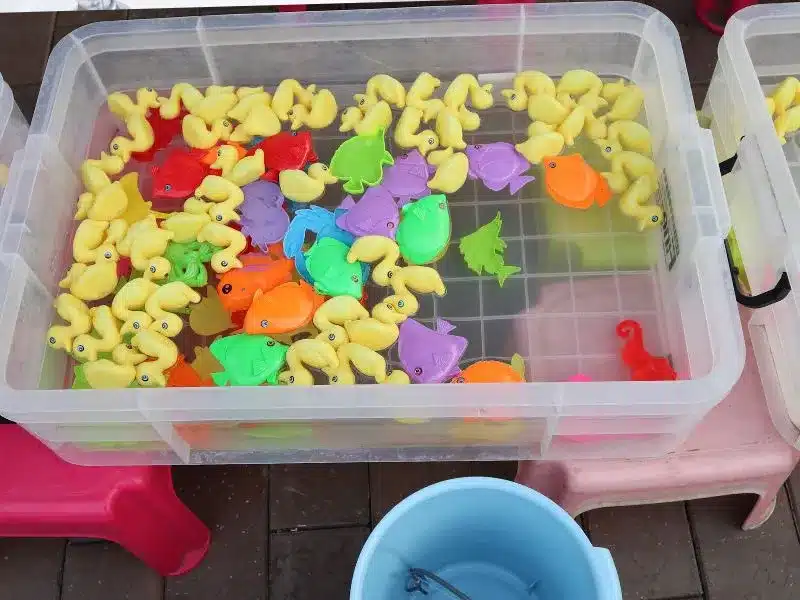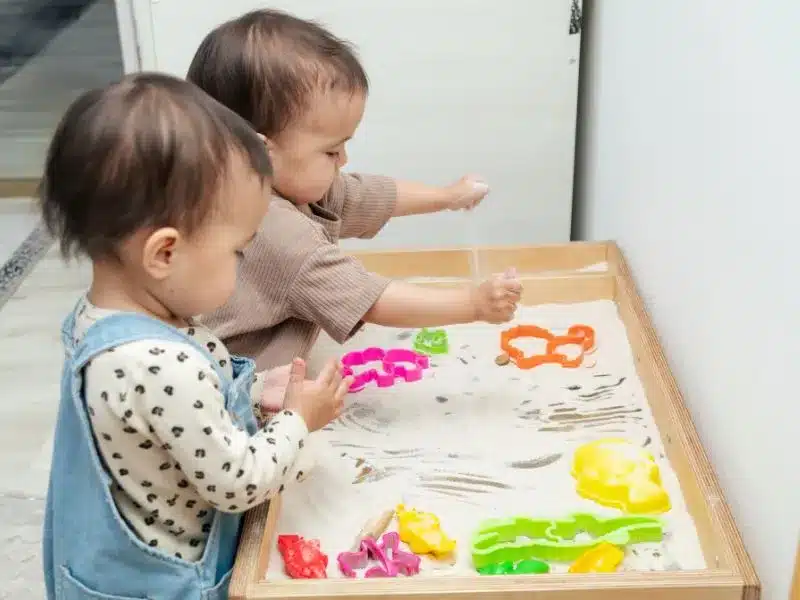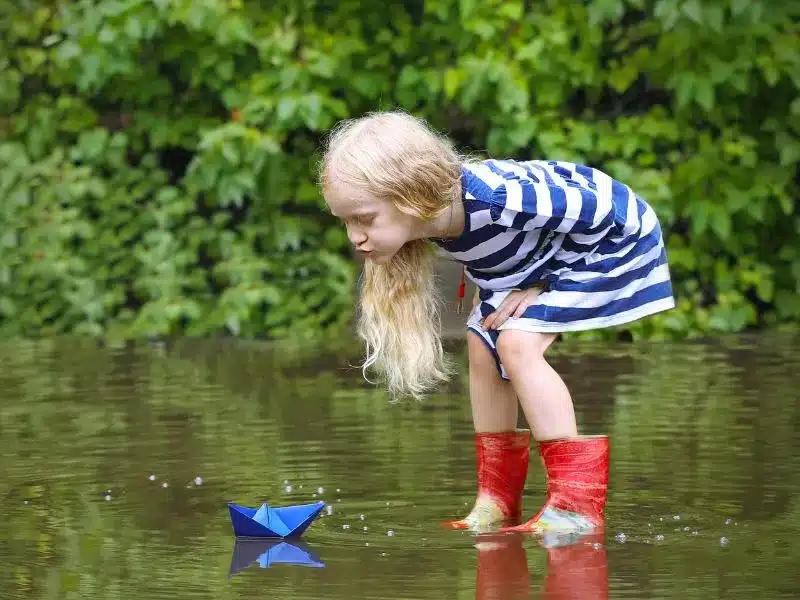9 SAND AND WATER PLAY ACTIVITIES FOR KIDS
Sand and water play is an important learning experience in early childhood education.
Starting from babies to preschoolers and beyond, sand and water play gives limitless joy, relaxation and skill development.
Related articles:

Sand and Water Play Activities for Different Developmental Stages
Infants (0-12 months)
- Splashing water
- Touch and feel the water and sand
Toddlers (1-3 years)
- Splashing water
- Identify hot and cold using sand and water
- Fill up containers with water and sand
- Mix water and sand
- Pouring water into cups and bottles
Preschoolers (3-5 years)
- Making waterways and bridges
- Sand castles, sand pies and sieve sand
- Use diggers and escavators to handle sand
- Sink and float activities
- Find volume activities using different-sized bottles
Sand and Water Play Activities
Sink or Float Experimentation

ColoUred Ice Sculptures

You can make coloured ice cubes using food colouring or huge ice chunks in glass containers. Before popping water into the freezer add interesting objects like flowers, twigs and small toys.
Once the ice blocks are ready, give them a toy hammer to break the ice or they can observe how ice melts and look at beautiful designs created on ice.
Treasure Finding

Add rocks, twigs and crystals to their sand pit or bin and let them explore.
Washing dishes

Kids love to immerse themselves in the kitchen and this is a great way for them to learn more about it. All you need is a toy kitchen set and these water sensory bins can keep kids occupied for hours.
Paper Boats

Paper boat making is a simple yet fun activity that captures children’s imagination as they fold and manipulate a piece of paper to make a floating boat.
It not only encourages creativity but also develops fine motor skills.
Paper boat making is perfect for beach, pool or makeshift water basin activities. It adds an extra level of excitement to your water play session and provides endless fun and learning opportunities for kids of all ages.
Sand Drawing
Make sand trays and use your fingers to write or draw on them. This is also a great way to begin learning letters.
Water Painting
Give children paint brushes and cups filled with water and let them paint designs on a surface like a concrete sidewalk or a wall outside.
This activity promotes gross motor skills as well as fine motor skills and encourages creativity.
Bubble play

Mix up a batch of bubbles with dish soap and water, and allow children to blow, pop, and chase them.
This activity develops hand-eye coordination and gross motor skills.
SENSORY DEVELOPMENT ACTIVITIES
A touch of silky smooth sand, the sound of water splashing and the earthy smell of sand mixed with water can give them a wholesome experience during their play.
What we can do:
- Offer different textures of sand – silky soft sand, sand chips and kinetic sand
- Show how a sieve works separating sand
- Show how adding different quantities of water can change the consistency- dry crumbles of sand, creamy sand or oozing sand
Tips for Promoting Effective Sand and Water Play
Provide a Safe and Supervised Environment
Sand and water play need to be supervised at all times. When children are playing with water, even if it’s a bucket full of water, it can pose a threat to their safety.
Offer a Variety of Tools and Materials
This is the key. Different tools and materials make the experience more interesting and open up so many ways for kids to experiment.
Offer containers of different sizes, spades, spoons, droppers, cups, and encourage them to find natural objects to play with.
Encourage Open-ended Play
Sand and water play has no set rules or adult guidance. Children get to imagine, be creative and express themselves with their own projects.
Facilitate Peer Interactions FOR SAND AND WATER PLAY
Children can play together as a group and there will be a lot of chatting and laughing during play. It’s a great way to make memories.
Incorporate Language and Literacy Development
Talking about measuring, building, transferring, decorating or repurposing requires them to use so many words that they may not use every day.
This will improve their language and literacy skills immensely.
Benefits of Sand and Water Play for Early Childhood Development
Sensory Development
Tactile Stimulation
Children’s sense of touch is stimulated as they explore different elements, textures and consistencies.
Visual Exploration
Children can add colouring to water and make coloured water.
Make sand castles and sand cakes and use twigs, rocks, sea shells or flowers to decorate them.
Auditory Experience
Water splashing, dropping objects on water containers and listening to the sound of sand under their feet, Dig and poke through the sand using shovels and sticks and listen to the sound.
All these sounds will help them experience joy to the fullest. Discover more about the wonders of nature through sensory experiences.
Cognitive Development
Sand and water play is not only a sensory experience. It allows children to think, make decisions, and solve problems in so many ways.
Sandcastle Building with Various Shapes
Making sand castles is not all that easy. They need to add water and make the right consistency for the castle to stick together.
Making square shapes and round shapes requires different containers, and children need to be aware of shapes.
Water Experiments with Measurement Tools
Using spoons, droppers, cups or baskets and knowing which one to use for the purpose.
For example, to fill up a basket, they need to use a cup not a dropper or spoon.
When pouring water from one container to another, they need to pick a container with a smaller opening to pour and a wider opening to hold.
When only a little water is needed, it’s always easier to use a dropper or spoon not a jar or bucket.
Learn more about measurement activities for kids.
Sorting and Classifying Seashells
On the beach, children can sort and classify seashells they find based on their colour, size or shape.
Fine and Gross Motor Development
Pouring and Transferring Water Using Containers
Using spoons, droppers, cups to pour and transfer water can improve children’s fine motor skills.
Digging and Scooping Sand with Shovels
Using spades, sticks or hands to dig, scoop, shape and flatten sand can also improve their fine motor skills.
Making Sand Tracks and Waterfalls
Making sand tracks for trucks using diggers requires them to use certain tools correctly to work their way through a pile of sand. Making a waterway and cutting it through rocks and stones to make a waterfall require a lot of fine motor skills.
Social and Emotional Development
Cooperative Sandcastle Building with Friends
Sand and water play has no restriction on the number of kids or their age. So it’s a place children of all ages can gather around and have fun.
It can be a place where children talk a lot, plan, help each other, execute their plans and celebrate the completion of their project.
Water Play with Turn-taking Games
Turn-taking is a skill that children need to learn during playtime.
Talking and Sharing Feelings during Water Play
Sand and water play is ideal for kids to play, have fun, share thoughts, crack a joke and have a good hearty laugh.
Wrapping Things Up
Sand and water play is a great way for kids to explore, learn, and grow. It’s a great way to develop fine motor skills, creativity, and imagination.
From building sand castles to splashing in the water, sand and water play activities are a great way for children to explore the world around them.
Not only do they provide endless fun, but they are also a great way for your little one to learn important concepts. From cause and effect to hand-eye coordination to problem-solving, water and sand play is an essential part of early childhood development.
So, let’s encourage our little ones to dive into the sand and water play world and learn, grow, and create lifelong memories.

Leave a Reply